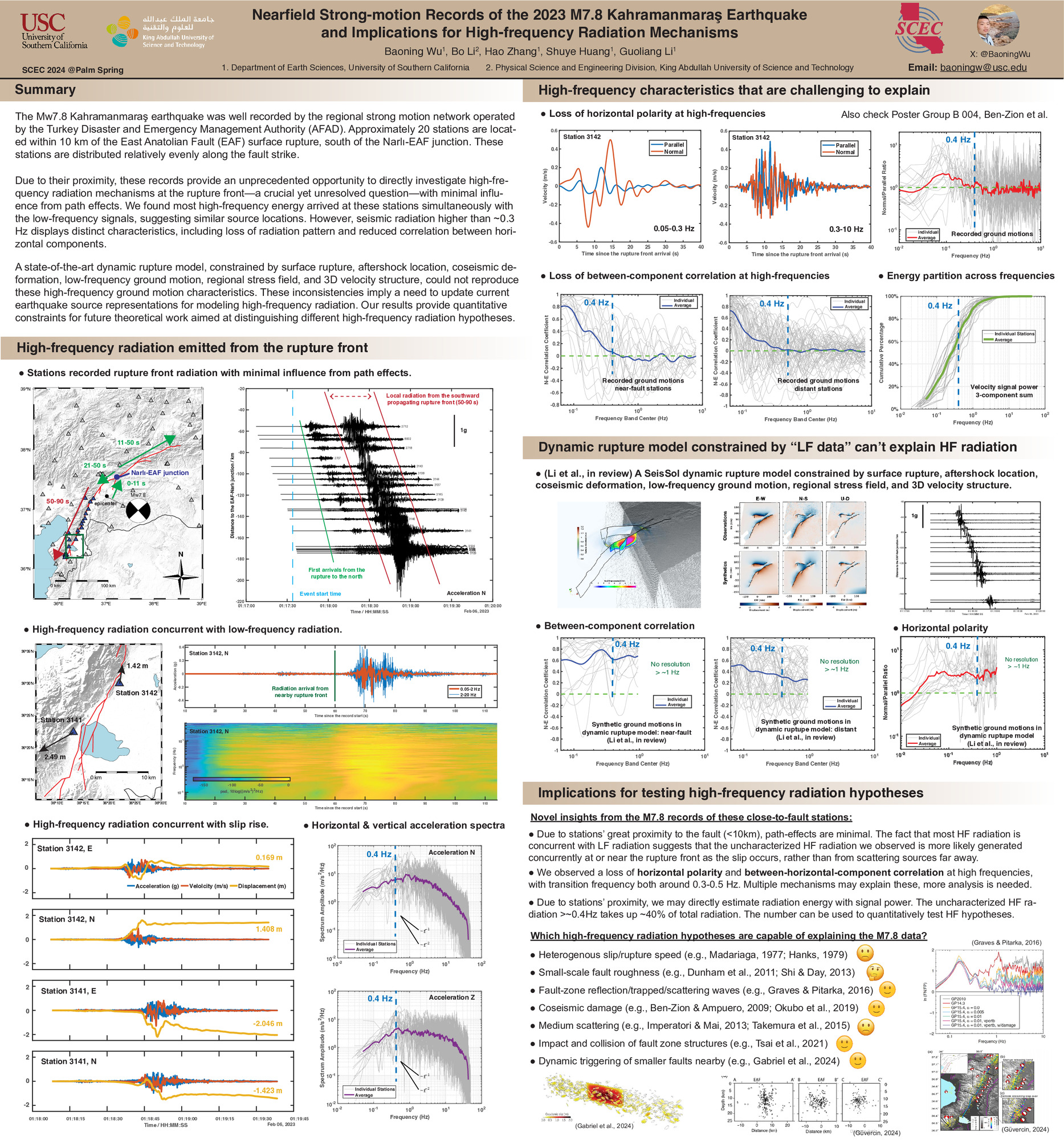Group A, Poster #015, Seismology
Nearfield Strong-motion of the 2023 M7.8 Kahramanmaraş Earthquake and Implications for High-frequency Radiation Mechanisms
Poster Image:

Poster Presentation
2024 SCEC Annual Meeting, Poster #015, SCEC Contribution #13624 VIEW PDF
Classic earthquake models adequately explain the seismic wavefield below the earthquake corner frequency. However, at higher frequencies, seismic radiation becomes markedly more complex and stochastic, losing phase coherence across stations and frequency bands. The high-frequency radiation mechanism is still under heated debate.
The first event in the 2023 Turkey-Syria earthquake sequence provides an excellent opportunity to investigate how high-frequency radiation is generated. The Mw 7.8 event was well recorded by the regional strong motion network operated by the Turkey Disaster and Emergency Management Authority (AFAD). Among them, 20 stations are located within 10 km of the EAF surface rupture south of the junction. These stations span rather evenly along the fault strike, recording seismic radiation from the rupture front as it propagated southward.
In this study, we investigate the high-frequency characteristics of the Mw 7.8 southern rupture using these 20 near-fault strong motion stations. We find that most high-frequency signal energy arrives at these stations alongside the low-frequency signals, suggesting that the high-frequency radiation is generated near the fault rather than by medium scattering. However, seismic radiations above ~0.3 Hz display distinct characteristics compared to their lower-frequency counterparts: high-frequency signals do not maintain discernible radiation patterns, and there may be multiple phases with different origins arriving simultaneously. Comparison with back-projection analysis suggests that high-frequency generation information is preserved even at distant stations. Our findings imply a need to update our current earthquake source representations for modeling high-frequency radiations. The results of this study may provide valuable constraints for future theoretical work aimed at distinguishing different high-frequency radiation mechanisms.
The first event in the 2023 Turkey-Syria earthquake sequence provides an excellent opportunity to investigate how high-frequency radiation is generated. The Mw 7.8 event was well recorded by the regional strong motion network operated by the Turkey Disaster and Emergency Management Authority (AFAD). Among them, 20 stations are located within 10 km of the EAF surface rupture south of the junction. These stations span rather evenly along the fault strike, recording seismic radiation from the rupture front as it propagated southward.
In this study, we investigate the high-frequency characteristics of the Mw 7.8 southern rupture using these 20 near-fault strong motion stations. We find that most high-frequency signal energy arrives at these stations alongside the low-frequency signals, suggesting that the high-frequency radiation is generated near the fault rather than by medium scattering. However, seismic radiations above ~0.3 Hz display distinct characteristics compared to their lower-frequency counterparts: high-frequency signals do not maintain discernible radiation patterns, and there may be multiple phases with different origins arriving simultaneously. Comparison with back-projection analysis suggests that high-frequency generation information is preserved even at distant stations. Our findings imply a need to update our current earthquake source representations for modeling high-frequency radiations. The results of this study may provide valuable constraints for future theoretical work aimed at distinguishing different high-frequency radiation mechanisms.















































